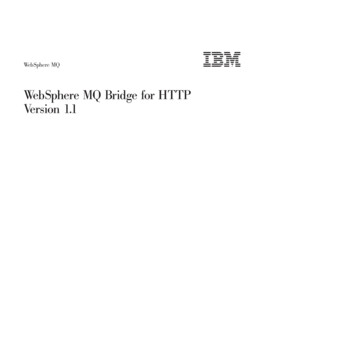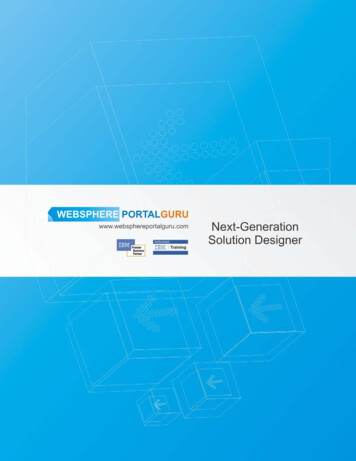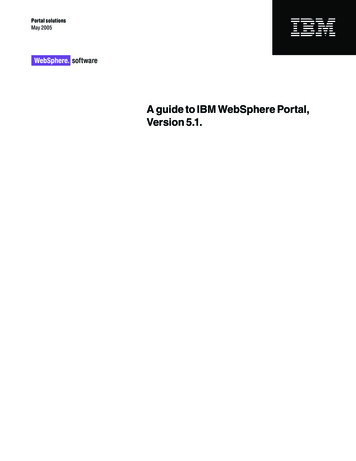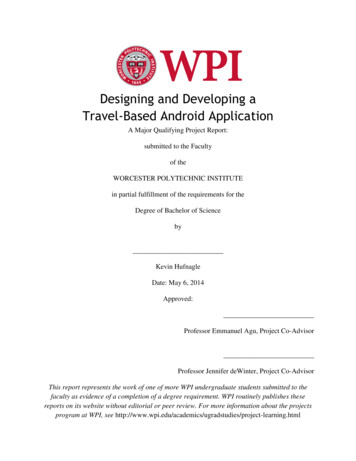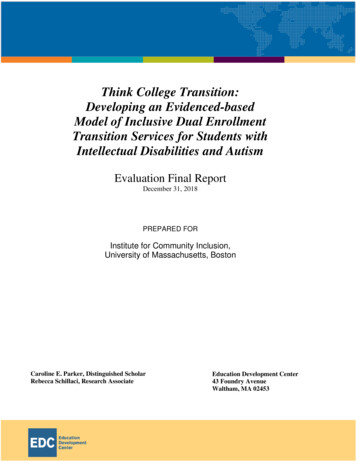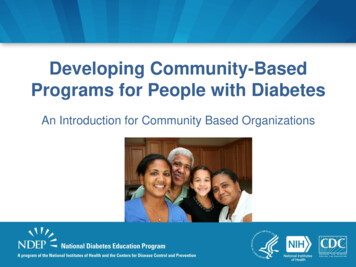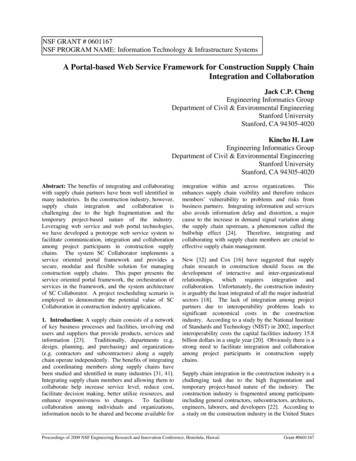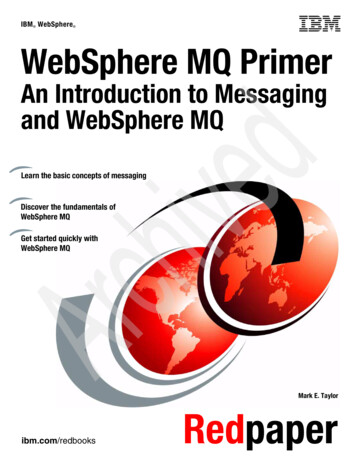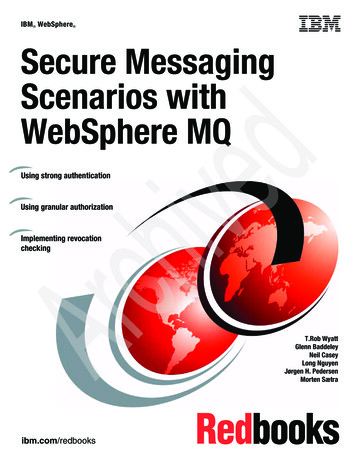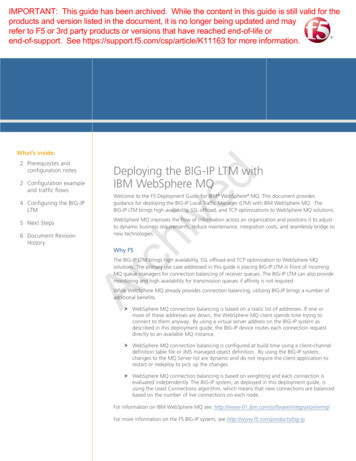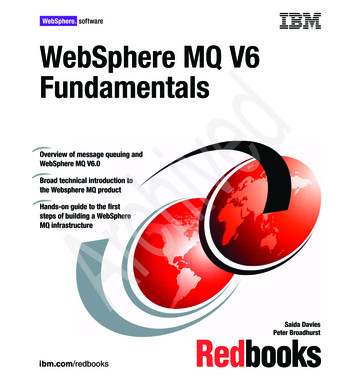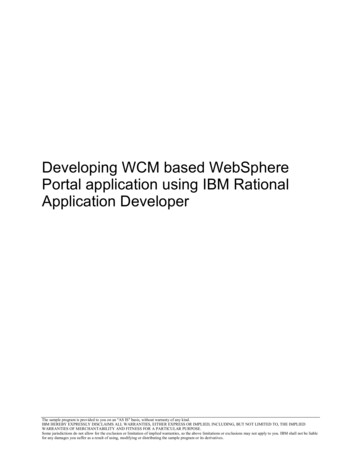
Transcription
Developing WCM based WebSpherePortal application using IBM RationalApplication DeveloperThe sample program is provided to you on an "AS IS" basis, without warranty of any kind.IBM HEREBY EXPRESSLY DISCLAIMS ALL WARRANTIES, EITHER EXPRESS OR IMPLIED, INCLUDING, BUT NOT LIMITED TO, THE IMPLIEDWARRANTIES OF MERCHANTABILITY AND FITNESS FOR A PARTICULAR PURPOSE.Some jurisdictions do not allow for the exclusion or limitation of implied warranties, so the above limitations or exclusions may not apply to you. IBM shall not be liablefor any damages you suffer as a result of using, modifying or distributing the sample program or its derivatives.
Table of ContentAbstract .3Sample Use case.3Prerequisite .3Developing the portlet project .4Connecting to WCM repository in Source portlet .5Fetching the list of WCM libraries.6Setting the default library and fetching the content .7Designing the view JSP for the Source portlet .9Connecting to WCM repository in Target portlet .10Modifying the TargetPortletSessionbean .10Designing the view JSP for the Target portlet .11Enabling Source Portlet to publish the event .12Enabling Target Portlet to subscribe to the event.14Deploying the portlet on WebSphere Portal.16Executing the use case on the server .17Summary .22Resources .22The sample program is provided to you on an "AS IS" basis, without warranty of any kind.IBM HEREBY EXPRESSLY DISCLAIMS ALL WARRANTIES, EITHER EXPRESS OR IMPLIED, INCLUDING, BUT NOT LIMITED TO, THE IMPLIEDWARRANTIES OF MERCHANTABILITY AND FITNESS FOR A PARTICULAR PURPOSE.Some jurisdictions do not allow for the exclusion or limitation of implied warranties, so the above limitations or exclusions may not apply to you. IBM shall not be liablefor any damages you suffer as a result of using, modifying or distributing the sample program or its derivatives.
AbstractContent management is playing an increasingly significant role in today's dynamic business world.The ease and efficiency to manage the web content throughout its lifecycle or workflows is the keyto the success of a business sites. IBM Web Content Manager included along with IBMWebSphere Portal provides a robust web content management solution to help customer managetheir content from creation to rendering phase. You can extend the standard features of IBM Web Content Manager (hereafter referred as WCM at some places) using the Web ContentManager API as well.The aim of this article is to showcase development of Web Content Management (WCM) basedportlets for WebSphere Portal using IBM Rational Application Developer V8.5. The articlewill cover how to use IBM Web Content Management API to build a portlet application and willalso provide a sample application to help you using the IBM Web Content Management API thatcan be downloaded. This article assumes that you are aware of IBM Web Content Managementand portlet development using IBM Rational Application Developer.The sample use case of this article incorporates fetching the content from a content repositoryusing WCM APIs.Sample Use caseIn this sample use case, you will work with a portlet project having two portlets that fetch andrender the content from WCM libraries. These portlets would participate in inter-portletcommunication by using the events mechanism provided by JSR 286 specification of portlet API.The first portlet would list the content libraries available at server and based on the library selectedit would fetch the content from the library and list the items in a HTML table. Content name in thefirst table would be a hyper-link, the second portlet would show the metadata and details of thecontent selected in first portlet. If the content selected in first portlet is an image resource type, itwould be previewed in the second portlet, for file resource type content there would be a linkprovided in second portlet to save and open the resource along with its metadata.PrerequisiteTo create the sample, install the following software:1) IBM Rational Application Developer version 8.52) IBM WebSphere Portal and Web Content Manager V8.0On skill level, you should know how to work with IBM Rational Application Developer andportlet development to simplify the process of project creation.You can prepare the development environment by installing IBM Rational Application Developerv8.5 and WebSphere Portal and Web Content Manager Server v8.0. You can import the sampleproject provided along with the article to IBM Rational Application Developer workspace tohave a detailed look. You need to import the content library to your Web Content Manager V8.0server before you try to execute the sample on server. You can refer the detailed instructions atWCM infocenter.The sample program is provided to you on an "AS IS" basis, without warranty of any kind.IBM HEREBY EXPRESSLY DISCLAIMS ALL WARRANTIES, EITHER EXPRESS OR IMPLIED, INCLUDING, BUT NOT LIMITED TO, THE IMPLIEDWARRANTIES OF MERCHANTABILITY AND FITNESS FOR A PARTICULAR PURPOSE.Some jurisdictions do not allow for the exclusion or limitation of implied warranties, so the above limitations or exclusions may not apply to you. IBM shall not be liablefor any damages you suffer as a result of using, modifying or distributing the sample program or its derivatives.
Developing the portlet projectYou would create a portlet project with two portlet. Use WCM IPC Sample as the portlet projectname, Source as the first portlet name and Target as the names for the second portlet. To create theportlet projectSelect File- New- Portlet Project. The Project creation dialog would launch Enter WCM IPC Sample as the name of the project name.Select WebSphere Portal v8.0 as your target runtime.Select the Create a portlet checkbox.Enter the Portlet name as Source.Click the modify button of the Configuration label, and select JSR286 as portlet API andBasic portlet as Portlet type.Click Finish.Figure 1: New portlet project wizardThe sample program is provided to you on an "AS IS" basis, without warranty of any kind.IBM HEREBY EXPRESSLY DISCLAIMS ALL WARRANTIES, EITHER EXPRESS OR IMPLIED, INCLUDING, BUT NOT LIMITED TO, THE IMPLIEDWARRANTIES OF MERCHANTABILITY AND FITNESS FOR A PARTICULAR PURPOSE.Some jurisdictions do not allow for the exclusion or limitation of implied warranties, so the above limitations or exclusions may not apply to you. IBM shall not be liablefor any damages you suffer as a result of using, modifying or distributing the sample program or its derivatives.
The portlet project containing the Source portlet would be created in the workspace. To create thesecond portlet i.e. Target portlet, Select File- New- Portlet. The Portlet creation dialog wouldlaunch Enter the Portlet name as Source. Select FinishFigure 2: New portlet wizardThe portlet project WCM IPC Sample would now contain two portlets, Source portlet and Targetportlet.Connecting to WCM repository in Source portletWorkspace is the core of the IBM Web Content Manager API. Content is created, saved, deletedand searched for in scope of a workspace item. A workspace is associated to a user and is aninterface to Web Content Manager. You would request for a workspace object from repositorysingleton.You would create the connection to the WCM repository in the init phase of the portlet itself. Theinit method of the portlet class would look like the code snippet below:Code Snippet 1: Init method of Source portletThe sample program is provided to you on an "AS IS" basis, without warranty of any kind.IBM HEREBY EXPRESSLY DISCLAIMS ALL WARRANTIES, EITHER EXPRESS OR IMPLIED, INCLUDING, BUT NOT LIMITED TO, THE IMPLIEDWARRANTIES OF MERCHANTABILITY AND FITNESS FOR A PARTICULAR PURPOSE.Some jurisdictions do not allow for the exclusion or limitation of implied warranties, so the above limitations or exclusions may not apply to you. IBM shall not be liablefor any damages you suffer as a result of using, modifying or distributing the sample program or its derivatives.
public void init() throws PortletException{super.init();try {myworkspace WCM API.getRepository().getWorkspace();if ( myworkspace ! null ){myworkspace.login();}else {System.out.println( "Unable to get a valid workspace. br/ " );}}catch (Exception e) {System.out.println("Exception " e.getMessage());e.printStackTrace();}}The statement WCM API.getRepository().getWorkspace() is responsible for fetching a workspaceobject to interface with WCM.Fetching the list of WCM librariesThere can be multiple document libraries available at server as per the configuration. To let theuser choose the desired library you need to fetch the list of available libraries from WCMworkspace and store the list of library names. To store the list you can define an ArrayList‘libraries’ as a list of strings and create the desired getter and setters for the same. As the list oflibraries is to be persisted at session level you would opt to use the session beanSourcePortletSessionBean generated along with portlet project by RAD. At a later stage whiledeveloping the GUI for the Source portlet you would map this list of document libraries to thedropdown to let user select the desired library.In portlet session bean SourcePortletSessionBean you would define an ArrayList to store the listof libraries, along with its getters and setters.Code Snippet 2: ArrayList to store the list of libraries in SourcePortletSessionBeanprivate List String libraries new ArrayList();public void setLibraries(String libText) {libraries.add(libText);}public List getLibraries() {return this.libraries;}To get the list of available document libraries in WCM, you would add the desired piece of code tothe getSessionBean method of the source portlet class.Code Snippet 3: getSessionBean method to fetch the list of libraries in SourcePortlet.java//Populate the drop down with list of libraries in workspaceIterator DocumentLibrary myLibraries myworkspace.getDocumentLibraries();if (myLibraries.hasNext()){while yLibraries.next().getName());}The sample program is provided to you on an "AS IS" basis, without warranty of any kind.IBM HEREBY EXPRESSLY DISCLAIMS ALL WARRANTIES, EITHER EXPRESS OR IMPLIED, INCLUDING, BUT NOT LIMITED TO, THE IMPLIEDWARRANTIES OF MERCHANTABILITY AND FITNESS FOR A PARTICULAR PURPOSE.Some jurisdictions do not allow for the exclusion or limitation of implied warranties, so the above limitations or exclusions may not apply to you. IBM shall not be liablefor any damages you suffer as a result of using, modifying or distributing the sample program or its derivatives.
}myworkspace.getDocumentLibraries() would fetch the list of libraries available in the workspaceand then sessionBean.setLibraries is storing the library names to the list iteratively.Setting the default library and fetching the contentTo allow selection of document library and fetch the contents from the selected library, you canrefer the following snippet in processAction method in SourcePortlet class.Code Snippet 4: Snippet from processAction method in SourcePortlet.javatry {DocumentLibrary myLibrary r(FORM DROPDOWN).toString());if (myLibrary ! null) {sessionBean.populatedocList(myworkspace, myLibrary);} // end of MyLibrary ifelseSystem.out.println("Library is null br/ ");} //end of try blockcatch (Exception e) {// Normally exceptions would be added to logsSystem.out.println("Exception " e.getMessage());e.printStackTrace();} //end of catch blockThe method populatedocList is implemented in SourcePortletSessionBean and is intended to setthe selected library as the workspace library and then search the content from the selected library.You can refer the following snippet in populatedocList method of SourcePortletSessionBean.Code Snippet 5: Snippet from populatedocList method of mentLibrary(myLibrary);QueryService queryService myworkspace.getQueryService();Query query tIterator resultIterator queryService.execute(query);The statement myworkspace.setCurrentDocumentLibrary(myLibrary) would set the selectedlibrary to the current workspace library. Then you would use QueryService to retrieve WCMDocument by DocumentQuery. For the use case we are limiting the scope to only twoDocumentTypes i.e. LibraryFileComponent and LibraryImageComponent . The result set ofquery execution would be stored in an iterator of WCM API query results i.e. resultIterator.The code snippet below would parse the result set and get the desired properties for the nodesreturned in result which would be referenced to render the details. You would store these details ina node docList and then final collection of these nodes would be maintained in another ArrayListof these nodes.Code Snippet 6: Snippet from populatedocList method of SourcePortletSessionBeanThe sample program is provided to you on an "AS IS" basis, without warranty of any kind.IBM HEREBY EXPRESSLY DISCLAIMS ALL WARRANTIES, EITHER EXPRESS OR IMPLIED, INCLUDING, BUT NOT LIMITED TO, THE IMPLIEDWARRANTIES OF MERCHANTABILITY AND FITNESS FOR A PARTICULAR PURPOSE.Some jurisdictions do not allow for the exclusion or limitation of implied warranties, so the above limitations or exclusions may not apply to you. IBM shall not be liablefor any damages you suffer as a result of using, modifying or distributing the sample program or its derivatives.
if (resultIterator.hasNext()) {while (resultIterator.hasNext()) {WCMApiObject resource (WCMApiObject) resultIterator.next();DocumentList docList new DocumentList();resourceName resource.getName();if (resource instanceof LibraryImageComponent) {resourceURL ((LibraryImageComponent) resource).getResourceURL();resourceCreator ((LibraryImageComponent) resource).getCreator();resourceDate ((LibraryImageComponent) DocumentList(resourceName, resourceURL, resourceCreator,resourceDate, LIB IMAGE COMP);setResult(docList);} else if (resource instanceof LibraryFileComponent) {resourceURL ((LibraryFileComponent) resource).getResourceURL();resourceCreator ((LibraryFileComponent) resource).getCreator();resourceDate ((LibraryFileComponent) DocumentList(resourceName, resourceURL, resourceCreator,resourceDate, LIB FILE COMP);setResult(docList);} //end of else if} // end of while} //end of resultIterator ifelse {System.out.println("No objects Found");} //end of resultIterator else}The SourcePortletSessionBean has another ArrayList result defined to store the result withadditional metadata that is required to display the details.Code Snippet 7: Snippet from SourcePortletSessionBeanpublic List DocumentList result new ArrayList();public void setResult(DocumentList obj) {result.add(obj);}public List getResult() {return this.result;}The element result is an ArrayList of type DocumentList. DocumentList is an additional beandefined to store the desired metadata of the content items. The snippet above references an elementtype DocumentList, setDocumentList is the setter method to save the metadata for this additionalbean.Code Snippet 8: Snippet from DocumentList.javapublic void setDocumentList(String resName, String resURL, String resAuthors,String resDate, String resType) {The sample program is provided to you on an "AS IS" basis, without warranty of any kind.IBM HEREBY EXPRESSLY DISCLAIMS ALL WARRANTIES, EITHER EXPRESS OR IMPLIED, INCLUDING, BUT NOT LIMITED TO, THE IMPLIEDWARRANTIES OF MERCHANTABILITY AND FITNESS FOR A PARTICULAR PURPOSE.Some jurisdictions do not allow for the exclusion or limitation of implied warranties, so the above limitations or exclusions may not apply to you. IBM shall not be liablefor any damages you suffer as a result of using, modifying or distributing the sample program or its derivatives.
this.name resName;this.url resURL;this.authors resAuthors;this.date resDate;this.type resType;}public DocumentList getDocumentList() {return (DocumentList) this;}Designing the view JSP for the Source portletThe objective of source portlet is to let user make a selection of WCM library and based on libraryselected, fetch and display the list of contents in a HTML table. You can refer theSourcePortletView.jsp in attached sample file to get the JSP details.Code Snippet 9: Snippet from SourcePortletView.jsp to display list of libraries % String formText sessionBean.getFormText();Iterator libLst sessionBean.getLibraries().iterator();Iterator resLst sessionBean.getResult().iterator(); % FORM method "POST" action " portlet:actionURL/ " LABEL for " % com.ibm.wcm ipc sample.SourcePortlet.FORM TEXT% " Select theWCM library : /LABEL BR select name " % com.ibm.wcm ipc sample.SourcePortlet.FORM DROPDOWN% " option value "" Select a Library /option % while (libLst.hasNext()) {String library (String)libLst.next();% option value " % library % " % library % /option % } % /select INPUT name " % com.ibm.wcm ipc sample.SourcePortlet.FORM SUBMIT% "type "submit" value "Submit"/ /FORM /DIV The code snippet above provides a dropdown with the list of libraries values populated usingsessionBean.getLibraries().iterator(). Once you make a selction and click Submit, the value oflibrary would be passed to populateList method through processAction method of SourcePortletclass to set it as a current library of workspace.To display the list of result set generated post selecting the library, you can refer the followingsnippet.Code Snippet 10: Snippet from SourcePortletView.jsp to display the content % if (resLst.hasNext()) { % table border "1" cellpadding "3" cellspacing "2" tr bgcolor "#c0c0c0" th align "center" valign "middle" Name /th th align "center" valign "middle" Authors /th th align "center" valign "middle" Creation Date /th th Resource Path /th The sample program is provided to you on an "AS IS" basis, without warranty of any kind.IBM HEREBY EXPRESSLY DISCLAIMS ALL WARRANTIES, EITHER EXPRESS OR IMPLIED, INCLUDING, BUT NOT LIMITED TO, THE IMPLIEDWARRANTIES OF MERCHANTABILITY AND FITNESS FOR A PARTICULAR PURPOSE.Some jurisdictions do not allow for the exclusion or limitation of implied warranties, so the above limitations or exclusions may not apply to you. IBM shall not be liablefor any damages you suffer as a result of using, modifying or distributing the sample program or its deriva
The ease and efficiency to manage the web content throughout its lifecycle or workflows is the key to the success of a business sites. IBM Web Content Manager included along with IBM WebSphere Portal provides a robust web content management solution to help customer manage their
